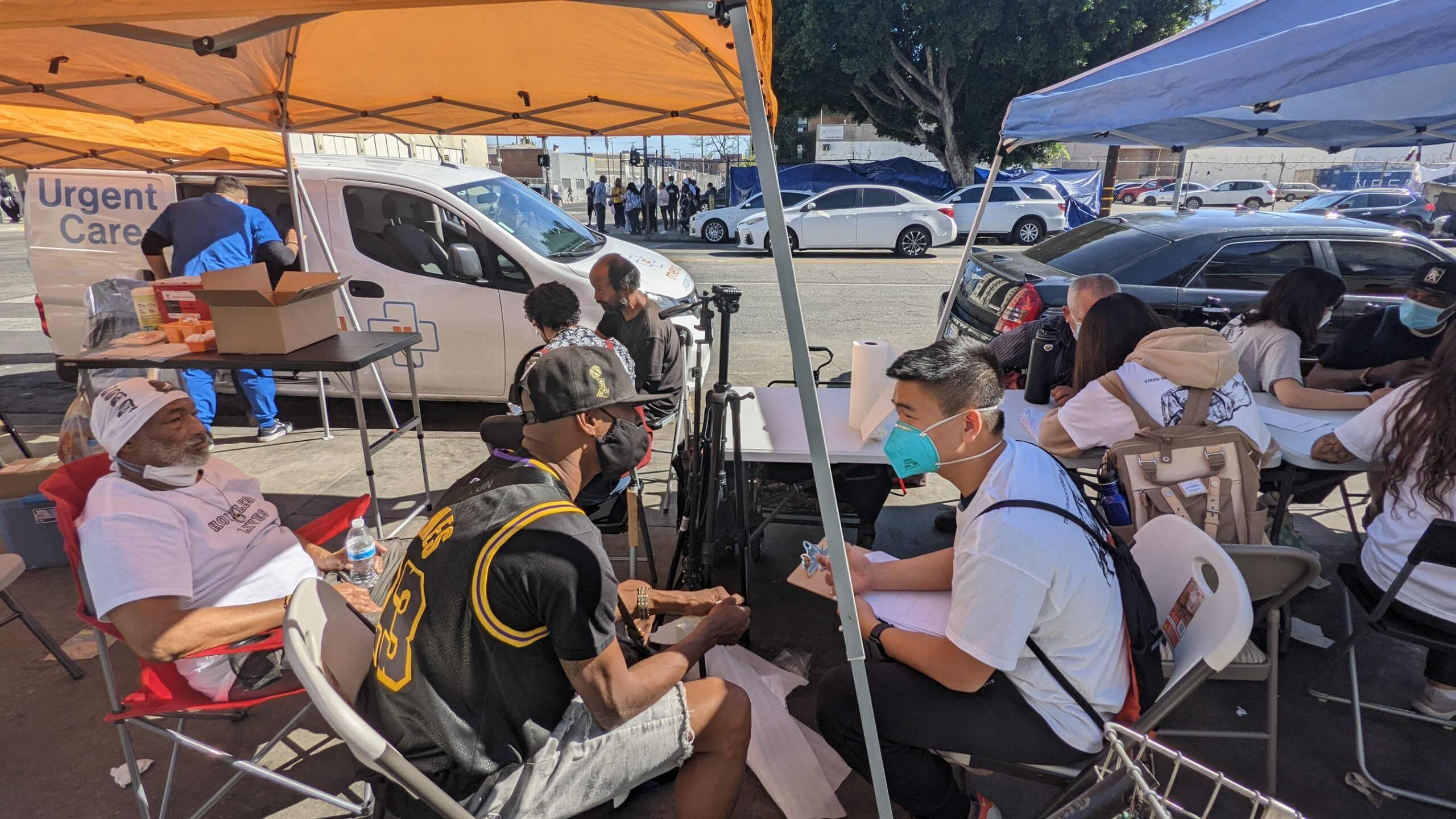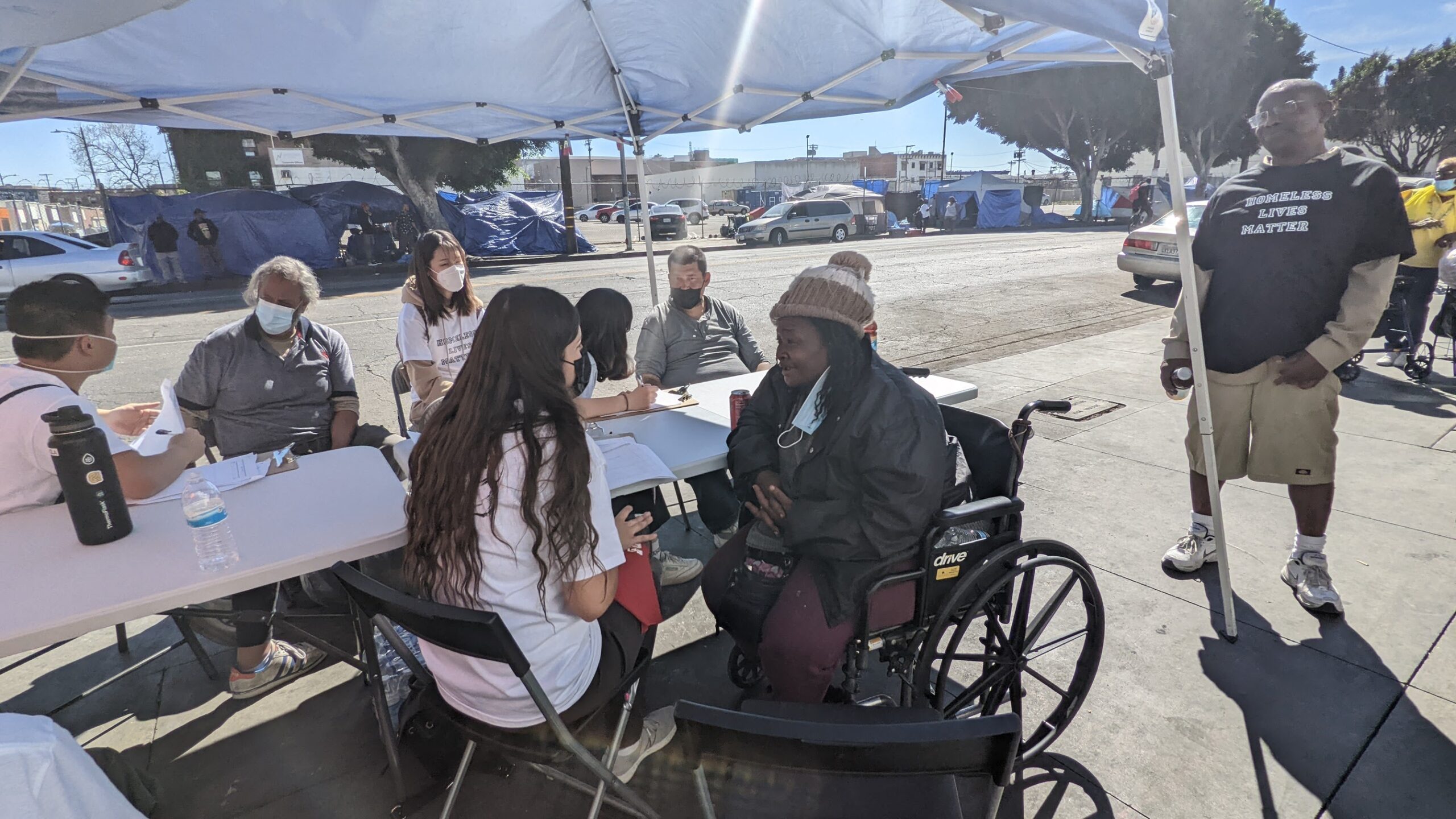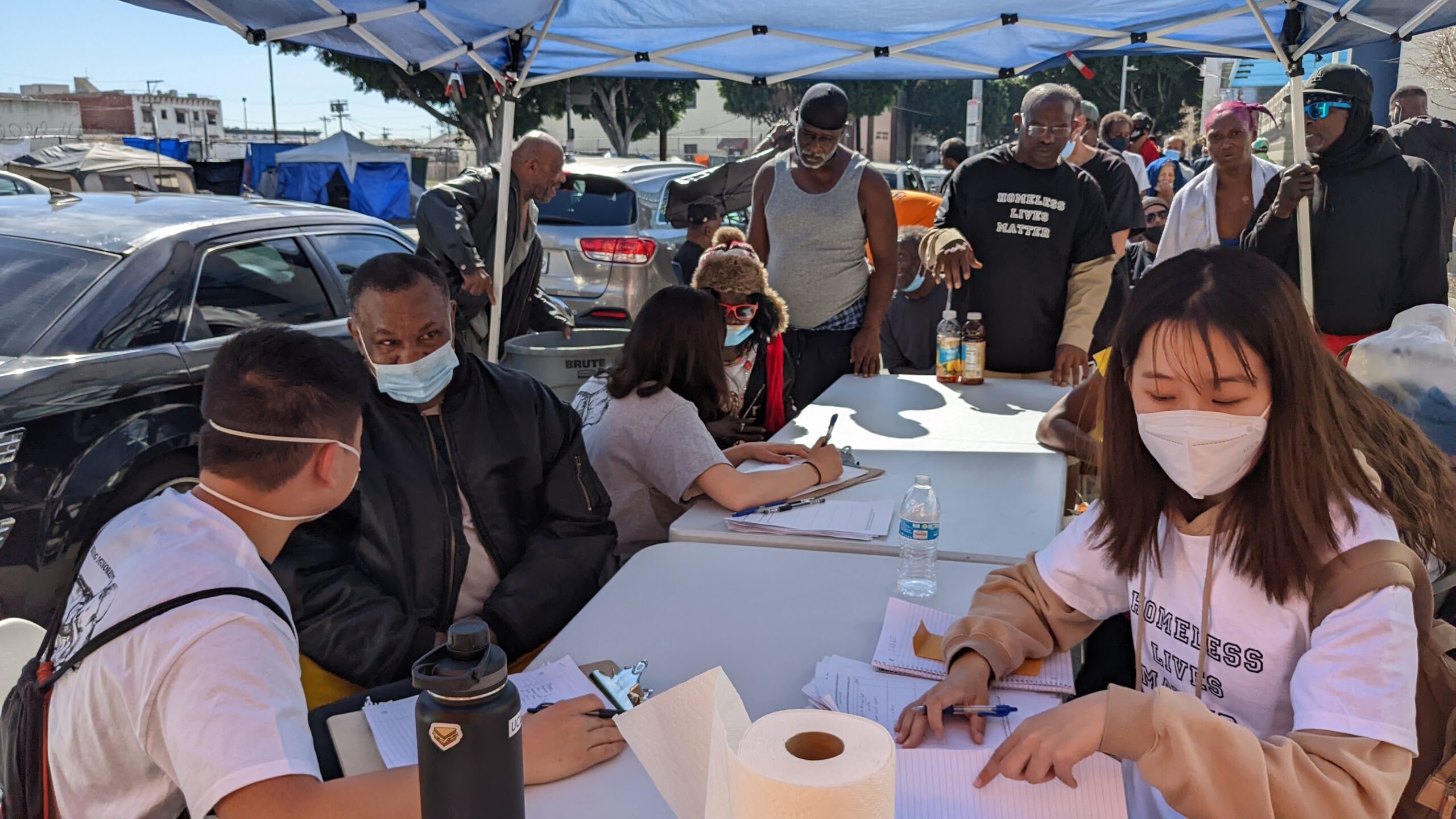Last Updated September 13, 2022 | Take the quiz
Quick Facts:
- When we asked 100 men and women experiencing homelessness in Los Angeles’s Skid Row what they would do about homelessness if they were mayor of Los Angeles, 62 named housing as the top priority.
- 84% of respondents named housing as one of their top three priorities and 92% named it in their top five priorities.
- Other categories people named in their top five priorities included life improvement resources such as education and job training (68%), necessities (54%) and healthcare (40%).
- Shifting the question to what the unhoused needed immediately, people named housing (36%), necessities (21%), and resources (16%) in the top three.
- The main difference between what people experiencing homelessness would do as mayor and what they would do in the short run was a decreased focus on housing and healthcare, and an increased attention to resources, necessities, and sanitation/safety.
- The average age of respondents in our survey in Skid Row was 54 years old; 76% were men and 67% were Black.
- The majority of respondents (86%) were chronically homeless; the self-reported length of homelessness ranged from one week to 55 years, with a median time of eight years.
Table of Contents
I. Executive Summary
II. Methodology & Demographics
III. Survey Results
IV. Focus Groups
V. Conclusion
I. Executive Summary
What would you do about homelessness if you were the mayor of Los Angeles? We asked 100 unhoused people in Skid Row this question to learn what policies they would like to see implemented.
In 2020, there were at least 66,436 people experiencing homelessness in Los Angeles County, a 13% increase from 2019. Just 28% of people experiencing homelessness were sheltered in January 2020, a few months before the COVID-19 pandemic began.[1]Los Angeles Homeless Services Authority, “2020 Greater Los Angeles Homeless Count Results,” LAHSA.org, June 12, 2020, … Continue reading The updated count released in September 2022 found an estimated 69,144 people experiencing homelessness, a 4.1% increase over 2020 (no count was taken in 2021).[2]Los Angeles Homeless Services Authority, “LAHSA Releases 2022 Greater Los Angeles Homeless Count Results,” lahsa.org, September 8, 2022, … Continue reading
Skid Row, a 55-square-block neighborhood in the heart of downtown Los Angeles, has an estimated 4,600 unhoused people, the highest concentration of homelessness in the nation.[3]Los Angeles Mayor’s Office, “Skid Row Strategies,” lamayor.org, accessed August 16, 2022, https://lamayor.org/skid-row-strategies
As we began to research issues related to homelessness in Los Angeles, we sought out studies that focused on the policy preferences of people actually experiencing homelessness. Unable to find such information at the time, we partnered with the UCLA Luskin School of Public Affairs to conduct a survey of 100 people experiencing homelessness in Skid Row.[4]In May 2022, RAND released a survey examining housing preferences of people experiencing homelessness. Two master of public policy students, Jason Ballou and Bofei Yan, conducted the survey under the guidance of professor Zachary Steinert-Threlkeld, PhD, with the help of four research assistants and two peer reviewers from UCLA. The Skid Row Brigade, a service group deeply embedded in the community, helped with recruitment, planning, and execution.
The survey asked people, “What would you do about homelessness if you were mayor of Los Angeles?” Researchers then asked, “What kinds of things would you do in the short run?”
Responses generally fit into the following categories:
- Healthcare – general medical care as well as mental health and substance abuse treatment;
- Housing – temporary, permanent, and affordable/low-income housing, in addition to shelter capacity and conditions;
- Necessities – food and water, clothing, toilets and showers;
- Resources – education, employment, transportation, money, and social workers;
- Sanitation/Safety – cleaner and more secure street conditions;
- Other – improve existing government and funding strategies, listen to the input of people experiencing homelessness.
The main difference between what people experiencing homelessness would do as mayor and what they would do in the short run was a decreased focus on housing and healthcare, and an increased attention to resources, necessities, and sanitation/safety.
Focus group participants offered more details into their experiences with homelessness. They talked about rules associated with housing programs that might make people less likely to participate, such as curfews, not allowing pets, and splitting up families to divide men from the women and children.
The focus groups also talked about security concerns, citing wariness of both the police and other unhoused people. Several participants spoke about the difficulty of completing basic tasks without a safe place to store their belongings, as well as a scarcity of hygiene resources such as toilets and showers. The student research team found that participants placed a high value on having their voices heard.
The survey results are explored below. The UCLA team's presentation of their results and policy analysis is titled, "Elevating the Voices of the Unhoused."
II. Methodology & Demographics
A. Methodology
On February 19, 2022, the UCLA team conducted short-form surveys with 100 unhoused participants on 6th Street in downtown Los Angeles in an area known as Skid Row. Ballou and Yan trained four UCLA student researchers to conduct the study. Led by Manuel Compito and Lynne Price-Compito, the Skid Row Brigade served as project coordinators. They explained the survey and its eligibility requirements, purpose, contents, and $20 cash incentive for participation. People signed up on a list and the project coordinators assigned them to available surveyors, who conducted live interviews with each participant and recorded responses in writing.
Due to COVID-19 safety concerns, the survey was conducted at a centralized location rather than at encampments or random spots on the street. As a result, the participants were a self-selected group who volunteered to take the survey, rather than being approached individually and asked to join. All participants and researchers were required to wear masks, which were provided on site along with hand sanitizer.
The survey consisted of four questions about participants' policy priorities and seven questions about demographics. Our goal was to identify the policy preferences of people who are currently experiencing homelessness. The primary question was "What would you do about homelessness if you were mayor of Los Angeles?" Researchers then asked what actions the respondent would take in the short run, and which people in Skid Row needed help the most. Click to view the full list of survey questions.
Respondents who named more than one policy were asked to rank their answers. Some listed as many as five policies, and some named more than one policy as a number one priority. The summary charts in the Executive Summary above only include the top three priorities named, while the results shown below include every respondent who named the policy category, regardless of priority ranking. One survey response was unusable for unknown reasons, so the results show the responses of 99 people.
B. Demographics
Gender: Men accounted for 76% of participants.
Type of Homeless: 86% of respondents in our survey were chronically homeless (defined as having experienced homelessness for at least a year, or more than four times in the past three years).
Race: Sixty-seven percent of respondents identified as Black, along with 10% Hispanic, 4% white, 4% Asian, and 15% multi-racial/other. Black people are over-represented either in our survey population, in Skid Row, or both: 8% of the general population in Los Angeles and 34% of the county's overall homeless population is Black.[5]Steve Lopez, "Column: Black People Make Up 8% of L.A. Population and 34% of Its Homeless. That’s Unacceptable," Los Angeles Times, June 13, 2020, … Continue reading
Age: The older generation appears to be over-represented in the Skid Row homeless population as compared to other areas of Los Angeles. Participants ranged from 30 to 77, with an average age of 54 years old.
Marital Status: Our survey population was predominantly unmarried (89% single, divorced, or widowed), while 11% were married or engaged.
Health/Disability: Nearly three-quarters of respondents (71%) self-identified as disabled. While some specified physical or mental disability, many did not. Serious mental illness was reported by 11% of respondents, and developmental disability by 5%.
Length of Homelessness: Participants self-reported having an unhoused status ranging from one week to 55 years. Many said they had experienced homelessness off and on over a long a period of time. On average, participants reported 12.3 years of homelessness (the median time was eight years).
Parent Status: More than half of respondents had at least one adult child (57%). Nearly a quarter (23%) had at least one minor child, while 77% had no children under the age of 18.
*Numbers might not add to 100% due to rounding or subjects declining to answer.
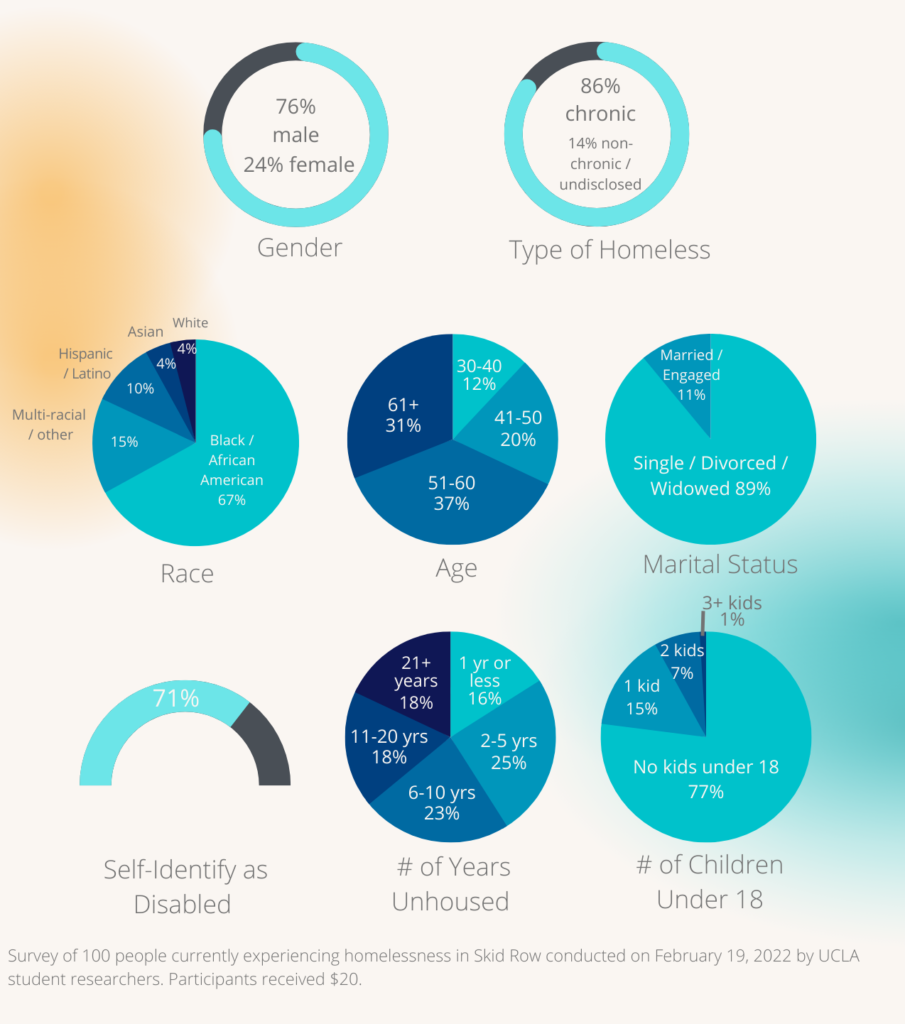
III. Survey Results
We identified six main categories of responses to the question of what a person experiencing homelessness would do if they were the mayor of Los Angeles (presented in order of how many people named each category as one of their priorities):
- Housing: Responses talked about programs and policies related to affordable interim and permanent housing, as well as improved conditions and increased capacity shelters.
- Resources: Participants identified a need for life improvement resources such as education and employment opportunities, job training, more social workers and case managers, community activities, and public transportation.
- Necessities: Survey responses cited a need for more food, clothing, blankets, and toiletries, as well as hygiene needs such as toilets, showers, and laundry facilities.
- Healthcare: In addition to general medical services, participants said that mental health and substance abuse services are needed.
- Other: Participants spoke about wanting to see improvements in the government's efforts to address homelessness. They also emphasized the importance of feeling heard and cared about by society.
- Sanitation/Safety: Respondents said they would do a better job keeping the streets and gutters cleaned to get rid of the rats and prevent people getting hurt. Some asked for an increased police presence, while others recommended better police training for officers working in the Skid Row area.
Click to view a full list of the policies preferred by people experiencing homelessness as named in our survey.
Housing
Housing was listed by 91 respondents as one of their priorities to address homelessness. Respondents said they would build more permanent housing, turn unused former hotels or hospitals into apartments, add temporary housing more quickly, and make more affordable/low-income housing. They also spoke about improving conditions in shelters and adding more staff. One person said there are too many rats and rapes in the shelters.
Housing was a top priority for a hypothetical mayor for 63% of all respondents, second priority for 15%, and third priority for 6%. All but three respondents over the age of 61 (90%) named housing as one of their priorities if they were mayor, and 73% of that age group placed housing as the top priority.
Survey participants noted a scarcity of available housing, and stated that barriers to housing should be removed to allow quicker and easier access to affordable housing. Nineteen people mentioned that more shelters are needed or that shelter staff and conditions should be improved. Three respondents said unhoused people need more shelters with either extended or no curfews.
Among racial demographics, multi-racial/other (73%) and Black (65%) had the highest preference for housing policies, while Hispanic/Latino had the least (40%). The age groups of 41-50 (75%) and 61+ (73%) were the most likely to cite housing as a concern.
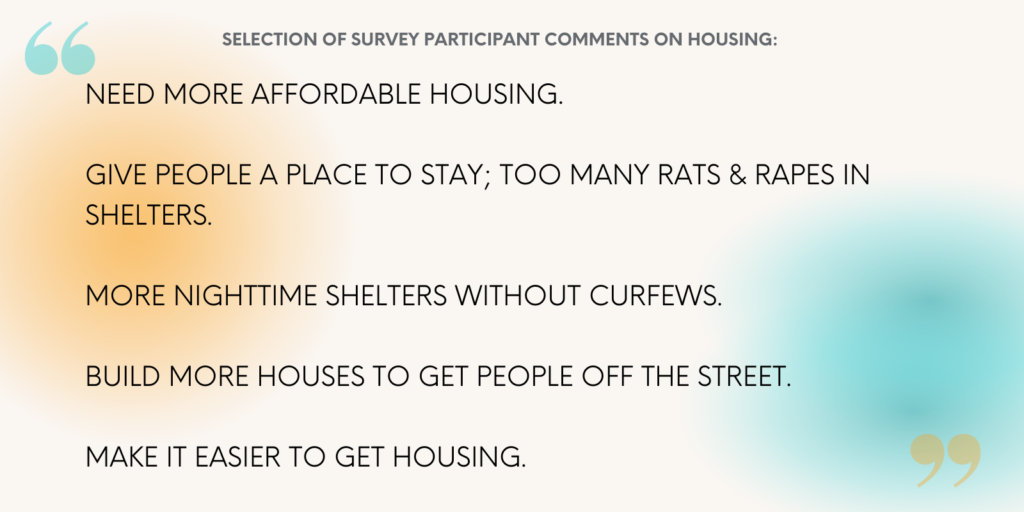
Resources
Resources were listed by 67 respondents as one of their priorities to address homelessness. Of those 67 people, 57% said they would provide job training programs, employment opportunities, or help getting a high school diploma and pursuing additional education.
Resources were a top priority for a hypothetical mayor for 10% of all respondents, second priority for 24%, and third priority for 9%. When people were asked about what they would do in the short term, resources increased in importance: 18% said they were a top priority in the short run, 17% listed them second, and 10% third.
Twelve respondents said they would hire more case managers and social workers, eight stated a need for entertainment, social, and exercise activities, and six talked about insufficient public transportation. Four people said they would provide a place for people experiencing homelessness to hang out during the day.

Necessities
Necessities were listed by 53 respondents as one of their priorities to address homelessness. Of those 53 people, 60% mentioned a need for more food, 53% wanted more access to toilets, showers, or laundry facilities, and 32% said people experiencing homeless need more clothing.
Necessities were a top priority for a hypothetical mayor for 6% of all respondents, second priority for 12%, and third priority for 6%. When people were asked about what they would do in the short term, necessities increased in importance: 21% said they were a top priority in the short run, 20% listed them second, and 4% third.
Fewer respondents over the age of 50 named necessities as a top priority as compared to people under 50, but necessities increased in importance as a second priority.

Healthcare
Healthcare was listed by 40 respondents as one of their priorities to address homelessness. Among those 40 people, 63% cited the need for more mental health services, including psychologists and therapy; 40% said more general medical services such as vaccines and check ups are needed; and 30% talked about helping people get off drugs with substance abuse treatment.
Healthcare was a top priority for a hypothetical mayor for 10% of all respondents, second priority for 11%, and third priority for 7%. When people were asked about what they would do in the short term, healthcare decreased in importance: 6% said it was a top priority in the short run, 6% listed it second, and 3% third.
The youngest age group in the survey, 30-40, had the highest percentage of participants listing healthcare as a top priority (17%). Overall, 42% of that age group named healthcare. The second-highest age demographic to select healthcare was 51-60 (36%).
Healthcare did not rank highly for any racial demographic: 12% of Black respondents, 10% of Hispanic/Latino, and 7% multi-racial/other named it as a top priority. No Asian or white participants listed healthcare as any level of priority when asked what they would do as mayor. One white respondent named it as third priority when asked what they would do in the short-term.
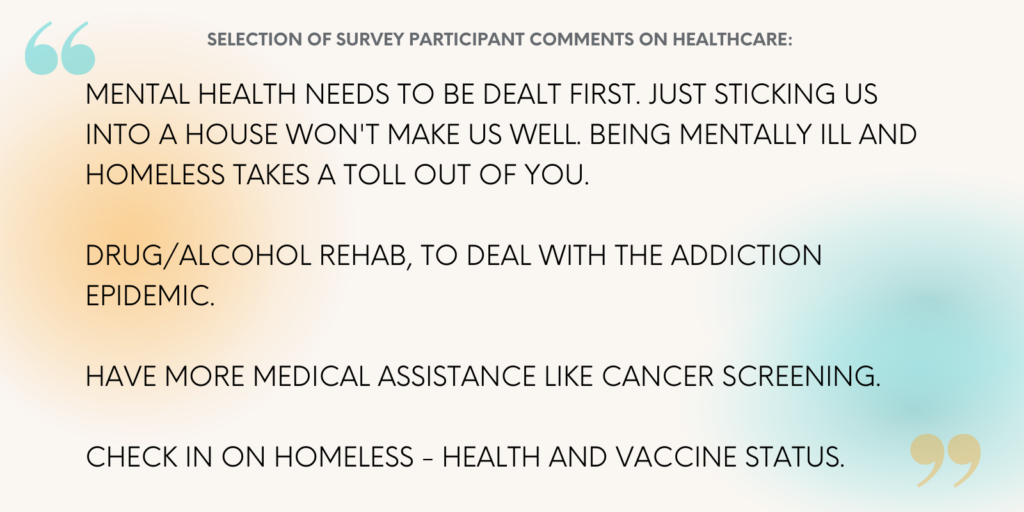
Other & Sanitation/Safety
Overall, 32 respondents named various policies that didn't fit well into a larger category and 31 respondents named a sanitation or safety policy as one of their priorities. Eleven people stated a need for more police or security guards.
Responses categorized here as "other" included a desire for people to listen to those experiencing homelessness, improving existing government responses, reforming the budget. Responses categorized as sanitation/safety talked about needing cleaner streets and an increased and improved police presence.
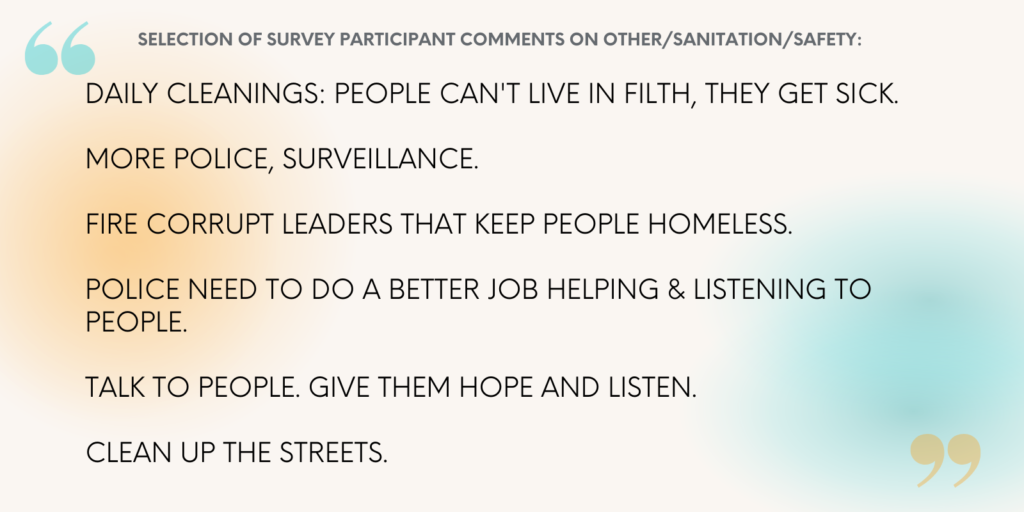
IV. Focus Groups
A one-hour women's focus group was held with six participants on February 25, 2022, and a senior men's focus group was held with five participants on March 6, 2022. Participants were given $30.
Women's Focus Group
Female participants mentioned housing nine times. They mainly talked about the barrier to secure housing and how the conditions should be improved to better accommodate unhoused people. They explained that waiting times are especially long for people who don't have a serious mental problem or substance use disorder, so some people who are chronically homeless but don’t have such problems feel as if they have to lie to get faster access to housing.
Some reasons shared for why unhoused people choose living on the streets rather than in affordable housing or shelters included a “no pet policy” enforced by most programs, as well as a lack of housing or shelter for family households that allow men to live with women and children. Two suggested housing improvements were adding more beds with lockers so they have space to store their belongings and training staff to treat people experiencing homelessness with respect.
In our women’s focus group interview, participants talked about safety issues four times. They shared that they have to be wary on the street and even in temporary housing, staying alert to potential danger from other unhoused people as well as police and staff surveillance. One participant shared her experience in a state temporary housing program program, Project Roomkey: "The security guards just open your room and come into your room. I could hear him go to all the other rooms as well. We complain to the people downstairs ... they don't even do anything."

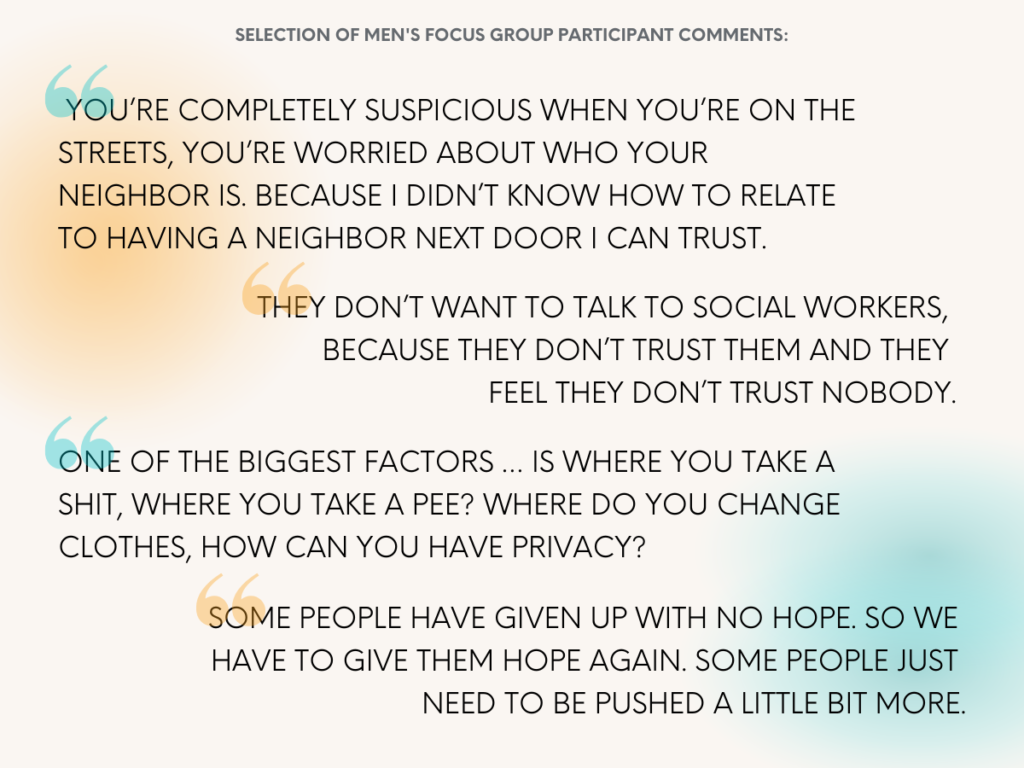
Men's Focus Group
Male participants talked about housing and shelters 18 times. One man said the strict curfew in the shelters or other interim options makes them feel like they are in prison, which is one reason why some people return to the streets after leaving a shelter or interim housing. They shared their concerns about the lack of privacy and how not having a place to store their belongings puts them at risk of losing their possessions. They also talked about the scarcity of cleaning facilities and the need for clean toilets, showers, laundry, and sanitation in interim housing and shelters.
Each participant reported having serious psychological problems or having experienced trauma, and most of the participants had alcohol and substance use disorders. They emphasized that people experiencing homelessness often feel marginalized and excluded from society, and talked about needing help with reentry after being unhoused. They named two specific programs that could help. First, educational programs to teach them coping skills and life skills. Second, social activities to help them build connections and receive peer support.
The men mentioned seven times that their concern for safety and their feeling of insecurity comes from police surveillance as well as other people on the street. Participants reported experiencing discrimination from the police, and said they felt unsafe in their surroundings after being victims of violence.
The student research team concluded: "The overarching lesson from the focus groups was that listening and caring provides hope for people experiencing homelessness. And concrete services for this population cannot be delivered effectively if we lack a connection and the ability to listen."
V. Conclusion
The purpose of this project was to learn what policies the people currently experiencing homelessness want to see enacted. We asked 100 people in LA's Skid Row neighborhood what they would do if they were mayor, and what they think needs to be done in the short term.
We found that housing was named by 92% of participants at some level of priority, followed by resources (68%), necessities (53%), healthcare (40%), and safety/sanitation (31%). Thirty-two percent named policies that we categorized as "other," including improvement to existing government and funding strategies and listening to the input of people experiencing homelessness.
Focus groups offered more details on how the way assistance is offered might impact the willingness of the homeless population to accept help. For example, programs that split up families or forbid pets might make some people turn down housing offers. The UCLA student research team found that many people they spoke to wanted to feel heard and cared about by society.
We hope that this survey will be helpful to policy makers and non-profit groups seeking to help people experiencing homelessness in Los Angeles.
Credits: Ataviz Consulting helped organize, code, and analyze the survey responses displayed on this page. Thank you to Bobby Buck for the survey photos.
References
| ↑1 | Los Angeles Homeless Services Authority, “2020 Greater Los Angeles Homeless Count Results,” LAHSA.org, June 12, 2020, https://www.lahsa.org/news?article=726-2020-greater-los-angeles-homeless-count-results |
|---|---|
| ↑2 | Los Angeles Homeless Services Authority, “LAHSA Releases 2022 Greater Los Angeles Homeless Count Results,” lahsa.org, September 8, 2022, https://www.lahsa.org/news?article=895-lahsa-releases-2022-great-los-angeles-homeless-count-results-released |
| ↑3 | Los Angeles Mayor’s Office, “Skid Row Strategies,” lamayor.org, accessed August 16, 2022, https://lamayor.org/skid-row-strategies |
| ↑4 | In May 2022, RAND released a survey examining housing preferences of people experiencing homelessness. |
| ↑5 | Steve Lopez, "Column: Black People Make Up 8% of L.A. Population and 34% of Its Homeless. That’s Unacceptable," Los Angeles Times, June 13, 2020, https://www.latimes.com/california/story/2020-06-13/column-african-americans-make-up-8-of-l-a-population-and-34-of-homeless-count-heres-why |

